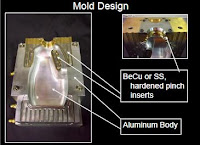A major attraction of plastics to designers is the ease with which fast assembly mechanisms can be incorporated into the end-product. A very good example of this is the snap fit. A typical design is shown in Fig. 2.22 although there are many variations. Snap fits exploit the fact that thin plastic sections can undergo relatively large flexural deflections for a short period of time and exhibit complete recovery. The design of snap fits is straightforward and does not involve creep curves since the time-scale of the deflectionlstress is small.
The point that will be illustrated here is that in a real design situations it is necessary to choose combinations of dimensions which provide the necessary function but which do not overstress the plastic. In the following example a set of design curves are developed to show how the different combinations of dimensions might be selected.
PLASTICS
ENGINEERING
Third Edition
R.J. Crawford, BSc, PhD, DSc, FEng, FIMechE, FIM
Department of Mechanical, Aeronautical
and Manufacturing Engineering
The Queen’s University of Belfast
The point that will be illustrated here is that in a real design situations it is necessary to choose combinations of dimensions which provide the necessary function but which do not overstress the plastic. In the following example a set of design curves are developed to show how the different combinations of dimensions might be selected.
PLASTICS
ENGINEERING
Third Edition
R.J. Crawford, BSc, PhD, DSc, FEng, FIMechE, FIM
Department of Mechanical, Aeronautical
and Manufacturing Engineering
The Queen’s University of Belfast







































